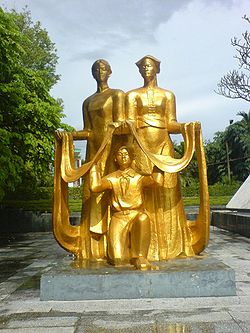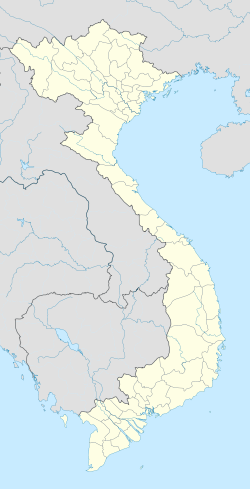- Dien Bien Phu
-
Dien Bien Phu
Thành phố Điện Biên Phủ— Provincial capital — Location in northern Vietnam Location of Dien Bien Phu in Vietnam Coordinates: 21°23′N 103°1′E / 21.383°N 103.017°E Country  Vietnam
VietnamProvince Dien Bien Province Điện Biên Phủ (
 listen) is a city in northwestern Vietnam. It is the capital of Dien Bien province, and is known for the events there during the First Indochina War, the Battle of Dien Bien Phu, during which the region was a breadbasket for the Việt Minh.
listen) is a city in northwestern Vietnam. It is the capital of Dien Bien province, and is known for the events there during the First Indochina War, the Battle of Dien Bien Phu, during which the region was a breadbasket for the Việt Minh.Contents
Population
Statistics on Dien Bien Phu's population vary depending on definitions — figures are generally between 70,000 and 125,000. The city is growing quickly, and is projected to have a population of 150,000 by 2020.[1] The majority of the population is not ethnically Vietnamese - rather, Thai ethnic groups form the largest segment. Ethnic Vietnamese make up around a third of the population, with the remainder being Hmong, Si La, or others.
Location within Vietnam
Điện Biên Phủ lies in Muong Thanh valley, a 20-km-long and 6-km-wide basin sometimes described as "heart-shaped". It is on the western edge of Dien Bien province, of which it is the capital, and is only a short distance from the border with Laos. Until the creation of the province in 2004, it was part of Lai Chau province.
The Vietnamese government elevated Dien Bien Phu to town status in 1992, and to city status in 2003.
History
The 8th century Thai locality of Muang Then is believed to have been centered here.
Transport
National route 12 connects Dien Bien to Lai Châu. Dien Bien Phu Airport serves the city with air route to Hanoi.
Past military conflict
Operation Castor (1953)
For more details on this topic, see Operation Castor.In the 1950s, the town was known not only for its famous opium traffic, generating 500,000,000 French Francs per year, but more so for a fierce battle that would result in a major realignment of world geopolitics. It was also an extensive source of rice for the Viet Minh.[2]
The region was fortified in November 1953 by the French Union force in the biggest airborne operation of the 1946-1954 First Indochina War, Operation Castor, to block Viet Minh transport routes and to set the stage to draw out Việt Minh forces.
Siege of Dien Bien Phu (1954)
For more details on this topic, see Battle of Dien Bien Phu.The following year, the important Battle of Dien Bien Phu was fought between the Việt Minh (led by General Vo Nguyen Giap), and the French Union (led by General Henri Navarre, successor to General Raoul Salan). The siege of the French garrison lasted fifty-seven days, from 5:30PM on March 13 to 5:30PM on May 7, 1954. The southern outpost or fire base of the camp, Isabelle, did not follow the cease-fire order and fought until the next day at 01:00AM; a few hours before the long-scheduled Geneva Meeting's Indochina conference involving the United States, the United Kingdom, the French Union and the Soviet Union.
The battle was significant beyond the valleys of Dien Bien Phu. Giap's victory ended major French involvement in Indochina and led to the accords which partitioned Vietnam into North and South. Eventually, these conditions inspired the United States to increase their involvement in Vietnam leading to the Second Indochina War. The battle of Điện Biên Phủ is described by historians as "the first time that a non-European colonial independence movement had evolved through all the stages from guerrilla bands to a conventionally organized and equipped army able to defeat a modern Western occupier in pitched battle."[3]
The Western fear of a Communist extension in Southeast Asia, named the Domino Theory by Dwight D. Eisenhower during the Dien Bien Phu siege and the departure of the French from Laos, Cambodia and Vietnam, was a factor leading to the direct American intervention in South Vietnam.
See also
Notes
- ^ Dien Bien Phu: Development and Conservation in a Vietnamese Cultural Landscape, William Logan, 2005
- ^ The Last Valley, Martin Windrow, 2004
- ^ Quotation from Martin Windrow. Kenney, Michael. "British Historian Takes a Brilliant Look at French Fall in Vietnam". Boston Globe, January 4, 2005.
External links
 Điện Biên ProvinceCapital: Điên Biên Phủ
Điện Biên ProvinceCapital: Điên Biên PhủĐiên Biên Phủ Phường: Him Lam • Mường Thanh • Nam Thanh • Noong Bua • Tân Thanh • Thanh Bình • Thanh Trường • Xã: Thanh Minh • Tà Lèng
Mường Lay Điện Biên Mường Lói • Mường Nhà • Mường Phăng • Mường Pồn • Nà Nhạn • Nà Tấu • Na Ư • Noọng Hẹt • Noong Luống • Núa Ngam • Pa Thơm • Sam Mứn • Thanh An • Thanh Chăn • Thanh Hưng • Thanh Luông • Thanh Nưa • Thanh Xương • Thanh YênĐiện Biên Đông Điện Biên Đông · Chiềng Sơ · Háng Lìa · Keo Lôm · Luân Giới · Mường Luân · Na Son · Nong U · Phì Nhừ · Phình Giàng · Pú Hồng · Pú Nhi · Tìa Dình · Xa DungMường Chà Mường Chà · Chà Nưa · Chà Tở · Huổi Lèng · Hừa Ngài · Ma Thì Hồ · Mường Mươn · Mường Tùng · Na Sang · Nậm Khăn · Pa Ham · Phìn Hồ · Sa Lông · Sá Tổng · Si Pa PhìnMường Nhé Mường Nhé · Chà Cang · Pa Tần · Nà Hỳ · Nà Khoa · Nà Bủng · Chung Chải · Mường Toong · Quảng Lâm · Nậm Kè · Sín Thầu · Nậm Vì · Na Cô Sa · Pá Mỳ · Sen Thượng · Leng Su SìnTủa Chùa Tủa Chùa · Huổi · Lao Xả Phình · Mường Báng · Mường Đun · Sáng Nhè · Sín Chải · Sính Phình · Tả Phìn · Tả Sìn Thàng · Trung Thu · Tủa ThàngTuần Giáo Tuần Giáo · Chiềng Sinh · Mường Mùn · Mường Thín · Nà Sáy · Phình Sáng · Pú Nhung · Quài Cang · Quài Nưa · Quài Tở · Ta Ma · Tênh Phông · Tỏa Tình · Mùn Chung
Media links
- (French) The situation of Dien Bien Phu, 50 years after the battle (French news, public channel France 2, May 5, 2004)
Coordinates: 21°23′N 103°01′E / 21.383°N 103.017°E
 Districts of Northwest Vietnam (Tay Bac)
Districts of Northwest Vietnam (Tay Bac)Dien Bien province Dien Bien Phu · Muong Lay · Dien Bien · Dien Bien Dong · Muong Cha · Muong Nhe · Tua Chua · Tuan Giao
Lai Chau province Son La province Hoa Binh province Categories:- Populated places in Dien Bien Province
- District capitals in Vietnam
- Districts of Dien Bien Province
- Provincial capitals in Vietnam
- Cities in Vietnam
- Dien Bien Phu
Wikimedia Foundation. 2010.



